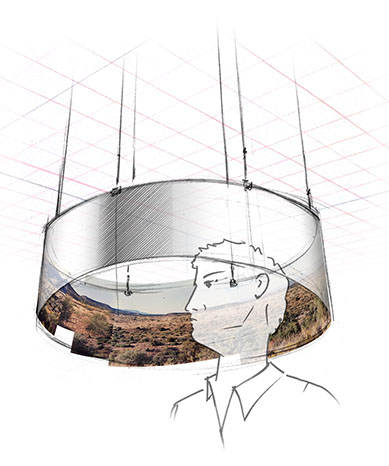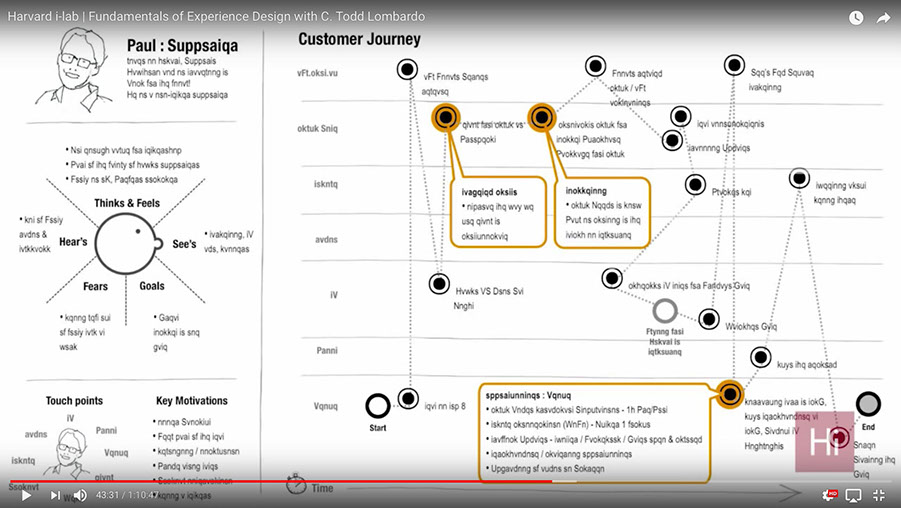DESN 570 — APPLIED DESIGN IN CONTEMPORARY SOCIETY | F 2019 | F 9:00–11:45AM | SS/PA 102

Analog Panoramic Views -
pre-Google Street Views
Immersive engagement without headgear and beyond the glass screen.
Take individual snapshot images in a panorama at some meaningful location (related to your zone of investigation), standing in one spot. Do not use the automatic panorama function in your camera.
Feel free to move the camera up and down as needed as well to include other interesting elements in the views, while going in the circle.
You should have some 15-20 photos to complete the circle, depending on the depth of the field you're capturing, ie proximity to the subject-matter.
Print your images individually on 4x6 (smaller ring) or 5x7 prints (larger ring).
Tape prints together into a cylindrical circle, reconstructing the panorama. One's head should be able to fit up inside the cylinder comfortably when done.
Using binder clips and string/mono-filament, suspend your panoramic VR. We will need to coordinate with Denny.
DUE: Final Exhibition, Dec 6 or 13.
"We spend most of our time trying to get design out of the way."
—Jony Ive
D2 | FIELD RESEARCH & PRESENTATION
2 weeks
PROJECT DESCRIPTION
Collaborative
Using Creative Research Methods, develop, and prepare content based on research (may be field, web, or another form such as direct experimentation, etc.) of design exhibitions, design organization activities, designer works, products, or service announcements, with examples of design thinking [d.school bootcamp bootleg PDF] and design strategy.
Here, we're creating content directly into prepared sites of inquiry.
Use the Analog Panoramas each of your cohorts have provided (previous session) as a site of investigation, reflection, understanding.
Your "Presentation" in this case is the Analog Environment and the collective contributions of your cohort team.
Feel free to make a larger panorama so we can really stand in it and focus our eyes (I realize now the 5x7s are too small; perhaps 8x10 photos is necessary), consider the following and using Post-its, Trace paper/Transparency overlays, and/or micro/minimal prototyping make insertions into the Panoramas of each of your classmates. Be mindful not to damage the native photos, so no destructive interventions, for ex. no permanent marker directly onto the photo surface itself. At least for now. Perhaps later we may have consensus that it would be more engaging and richer if we open ourselves, our panoramas to more direct modification. To be discussed.
To design for Humans, we need to better understand Humans, and our relationships to our world.
Consider employing
Sensory Charts (Jinsop Lee) for at least 4 specific conditions
Empathy Maps (11x17") for at least 2 humans engaged with your chosen research framework.
- Empathy map, why and how to use it - InteractionDesign.org
- Empathy Mapping - David Gray, Gamestorming.
- What is an Empathy Map? - David Bland, SolutionsIQ. April 21, 2016
Journey Map (11x17") to better understand opportunities
- Journey Mapping 101 - Nielsen Norman Group [Don Norman
Understanding Mind Maps or Mental Models
You do not have to limit your considerations to just the humans you see in the environments, you may wish to impart knowledge/insights to the objects, buildings, landscape elements, time of day, season, textures, and what these things do, what are they for, why, in what ways.
You may have, there may be opportunities where this can be utilized with
your 585 program. By all means please incorporate it into that work.
This is a work-in-progress that may be used throughout the semester and for installation at your final exhibition. It is not in and of itself an end-product this week.
Are there ways to engage other senses? How many senses can we
engage on this challenge?
Ask, how does this environment change if it did/had/insert ...?
(SLOs 1,2,3,4,5)
REFERENCES
See list of "570 Topics" links on right sidebar.
Definitions
- Creative research is creative production that produces new knowledge through an interrogation/disruption of form vs. creative production that refines existing knowledge through an adaptation of convention. It is often characterized by innovation, sustained collaboration and inter/trans-disciplinary or hybrid praxis, challenging conventional rubrics of evaluation and assessment within traditional academic environments.
- Creative research is the name of an emerging field that seeks to develop new ways of understanding, situating, and reconfiguring knowledge in the telematic age...
Research Methods, Nielsen Norman Group
Personas by Lene Nielsen, from The Encyclopedia of Human-Computer Interaction, 2nd Ed.. Interaction Design Foundation
Watch
- The problem with “personas” - John Maeda. Counter-point
- Diversity and Inclusion - John Maeda
- Identify what might be your Lacuna?
Strategy vs Tactics. Knowing the difference, makes all the difference
Strategy without tactics is the slowest route to victory.
Tactics without strategy are the noise before defeat."
—Sun Tzu
We need to take a long-term view and think ahead, while choosing short-term steps to take now for the sake of what we want later."
"Strategy newbies often get confused over the difference between strategy and tactics. ...Strategy is about activities that lead to differentiation. ...Tactics are how strategy gets implemented. They are the specific activities that we execute to realize a strategic intent. A tactic along cannot produce a winning result. ...The daily activities of most UX designers and researchers are tactical."
"It's not the customer's job to know what they want."
—Steve Jobs
TUTORIALS & HOW-TO GUIDES
Strategic Design Approach
- Wide view product experiences
- More than just an app or site
- Service Design
- Marketing strategies
- Social interactions
- Supporting Employee Experiences
- Physical experiences
- Sound/ Touch /Visual
- Create a vision based on informed research
- Create what people want
- Stakeholder’s may not know what they should do
Tactical Design Approach
- Focus on an app/site
- The refinement of a process to execute an app/feature or site
- UX/UI of the app or site
- Navigation/Heuristics
- Visual Design
- Create decisions based on user feedback and stakeholder input
- Create what people need
- Stakeholder’s already have a vision — just need someone to create it
PROCESS & DELIVERABLES
Part 1
Reading, Locating, and Construction of an Analog Panorama for collective interaction and intervention. The Panorama you have provided is a place that is no longer within your personal control. It belongs to the collective, society, your cohorts.
Part 2
Considering the methods of research provided above, intersect with each one of your cohort's Analog Panoramic Views. You may use any medium available, including video. Consider how a video may be inserted/incorporated, I don't have the answers.
- Drawings
- 3D Prototypes (making physical studies)
- Images (photography, generally)
- Graphics (charts, maps, diagrams)
- Media (audio-video product)
Students may wish to adopt a specific post-it color for their intervening as another way of tracking their observations/interventions.
With each interaction, students must include their initials, so we can identify the author of that .
If someone comments on something specific, you may ADD to the commentary, but you should not try to over-ride a view point that was inserted before you. No fighting. Build on, add to.
DO NOT overly invent. For example, you see a woman in a scene. You do not need to make up a name for her, simply describe her as you see her. She's a young woman of about college age, ... Be mindful, and respectful of culture, religion, race, etc. We are not interested in perpetuating stereotypes, tropes, etc. We are trying to gain insights into human engagement, interactions, etc.
Each student should make at least 3-5 observations/interventions into each cohort's panorama.
Use FACTUAL information or even data to support a notation. Where did you get the data, or what is your assumption? Be clear that it's a researched item or an opinion.
Part 3
Create a notational record list of each comment/intervention you've made
on each panorama.
Do not describe the panorama as "Luna's panorama", but instead use a
more universal description that identifies it clearly to a larger audience.
ex, Intersection at the Observatory in OC, with tall buildings at sunset.
Provide a single sheet, printed that accounts for your interventions.
Include your name on the sheet.
EVALUATION BREAKDOWN
points2020202020criteriaAdherence to project instructionsFormat & Structure of Document (shows process)Content/ResearchAbility to satisfy requirements of BriefAdherence to Design Conventions
EXAMPLES
There are no specific examples of this applied to such an "object" as this is a new interaction opportunity that is off-line.
Some additional references, inspirations
Vito Acconci. Following Piece. 1969
Diller and Scofidio. Overexposed. c. mid-90s. A study in voyeurism, early works.
Rear Window (film). Alfred Hitchcock. 1954. The story of a recuperating news photographer who believes he has witnessed a murder. Confined to a wheelchair after an accident, he spends his time watching the occupants of neighbouring apartments through a telephoto lens and binoculars and becomes convinced that a murder has taken place.
Professor Nicholas Christakis interview with Joe Rogan on the ethics and challenges with human-computer and human-human interactions.
Jer Thorp, The Weight of Data. TEDxVancouver. A human perspective on data.
Empathy map taken from C Todd Lombardo's Harvard i-lab,
Fundamentals of Experience Design

Counterpoint to "surveys," "needs analysis," etc.. Seth Godin, Your Job is to Make Art, (26min). It takes a leap of imagination sometimes to create something new and at the margins is where you have the greatest opportunity for real success.
STUDENT LEARNING OUTCOMES
1. Develop content for design communication based on research and understanding of contemporary design issues as demonstrated in multi-media and written assignments.
2. Demonstrate understanding of Genre and Disciplinary Conventions through writing projects specific to the discipline of design as demonstrated through appropriate writing styles across a range of discipline specific communication tools.
3. Evaluate influence of context and assumptions on the cultural, social, environmental and economic factors that affect contemporary design as demonstrated through creation of communication tools customized to
meet design project demands.
4. Develop conclusions and evaluate related outcomes of the interdisciplinary context of design as demonstrated through projects addressing applied design in an interdisciplinary context.
5. Demonstrate existing knowledge, research or views from previous design courses and experience as demonstrated through comparisons to design-specific historical and experiential references.
* Estimate only. See instructor and calendar for specific due dates. Summer Session schedule is more compressed with one week equal to approximately two and half semester weeks.
CSULB | COTA | DEPARTMENT OF DESIGN | BIO

Questions, feedback, suggestions?
Email me with your recommendations.
©2020 Michael LaForte / Studio LaForte, All Rights Reserved. This site and all work shown here is purely for educational purposes only. Where ever possible student work has been used or original works by Michael LaForte.
Works by professionals found online or in publication are used as instructional aids in student understanding and growth and is credited everywhere possible.